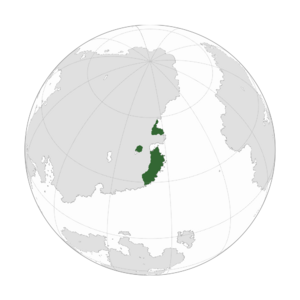Fluvannia
This article is incomplete because it is pending further input from participants, or it is a work-in-progress by one author. Please comment on this article's talk page to share your input, comments and questions. Note: To contribute to this article, you may need to seek help from the author(s) of this page. |
Federated Principality of Fluvannia Liitovaltion Ruhtinaskunta Kolmemaata Bundesfürstentum Fluvannien ふるばにやの連邦政府公国 (Furubaniya no renbōseifu kōkoku) | |
|---|---|
|
Flag | |
| Motto: Ex Fortitudine Pax ("Peace Through Strength") | |
| Anthem: O Triune Realm | |
 | |
| Capital | Oshkosh |
| Largest city | Rochester |
| Official languages | Fluvan |
| Recognised regional languages | Vinn, Burgwieser, Umitaku |
| Demonym(s) | Fluvannian |
| Government | Federal constitutional principality |
• Crown Prince | Michael |
| Legislature | Federal Assembly |
| High Council | |
| House of Delegates | |
| Federated from personal union | |
• Marital union between Piedmont and Monroe | 1213 |
• Winnebagan Accession | 1620 |
• Act of Union | 1826 |
| Area | |
• Total | 2,809,208 km2 (1,084,641 sq mi) |
| Population | |
• 2020 census | 213,840,408 |
• Density | 76.12/km2 (197.1/sq mi) |
| GDP (PPP) | 2020 estimate |
• Total | ℳ11.156 trillion |
• Per capita | ℳ52,172 |
| HDI (2020) | 0.893 very high |
| Currency | Mark (ℳ or |
| Time zone | UTC-1 to +0 (RST, GBT) |
| Date format | YYYY/MM/DD (numeric) [Month] DD, YYYY (alphanumeric) |
| Driving side | right |
| Calling code | +13 |
| Internet TLD | .fl |
Fluvannia (officially the Federated Principality of Fluvannia) is a nation comprised of three discontiguous regions in eastern Abos, bordered by the Sarasta Ocean to the east and south, and Dunferm to the west. The capital, Oshkosh is located in the northwestern part of the country, along the shore of Lake Winnebago. The nation's largest city is Rochester, located in the smallest of the three regions, the westerly-located County of Monroe. Other major cities include Charlottesville, Green Bay, Appleton, and Scottsville. Formed in the early 19th century from what had been a personal union of three separate polities, Fluvannia is as a result a large and geographically diverse nation, inhabited by approximately 213.84 million people as of the 2020 census. A federal constitutional monarchy, Fluvannia is comprised of two duchies and a county, each of which possess a high degree of autonomy. Unlike the case of many constitutional monarchies, the Fluvannian monarch, titled the Crown Prince, plays an active but nonpartisan role as the head of the nation's executive branch. Popular democracy is exercised by the legislature's lower house, the House of Delegates. Over 8.9 million people live in the Greater Rochester area, the largest in the country, which has functioned as a hub for trade since medieval times.
Etymology
Fluvannian territory has been inhabited for millennia by various peoples; a reference to the "populus qui colunt fluvium annum" ("the people who cultivate the yearly river"), describing the villages along the Rivanna River, shows that agriculture has been associated with the Charlottesville area since antiquity. In the north, references to the hunter-gatherer Viinebeiko people -- often in the context of pillaging -- can be found in Iron Age manuscripts. The Vinnibeiko name would eventually be fluvanized as Winnebago, and the Duchy of Winnebago today serves as the home for the majority of the Vinns, the modern ethnicity descended from the Vinnibeiko tribes.
History
Over time, various feudal realms arose in each of the three regions, resulting in a complex network of intermarriages, rival claims, and warfare. Sometimes these realms would turn to outsiders for help; one such marital alliance, between Thomas, Duke of Piedmont and Joanna, Countess of Monroe in 1213, would lay the groundwork for the modern Fluvannian state. The Duchy of Winnebago would join the personal union in 1620, when the last of the Kaukaunainen line died without issue; vassal counts, unable to settle on one of their own as new sovereign, instead decided to offer the ducal throne to a powerful ally, Richard, Duke of Piedmont. A long process of noble marriages and inheritances brought increasing power to the respective nobles of the now-Fluvannian constituencies, but in the Enlightenment Era much of this power was devolved to local and regional governments. The Act of Union of 1826 saw the Duchy of Winnebago, the Duchy of Piedmont, and the County of Monroe united under a single legal crown.
Geography
From the boreal forests near the Arctic Circle, to the temperate Sarasta Ocean coastline of the Duchy of Piedmont, to the humid boreal savannah of the Poyoinean interior, the Fluvannian landscape plays host to a number of different biomes.
Flora and fauna
Demographics
Population
Language
Due to the various peoples that have existed within the Fluvannian homeland for centuries, multiple languages are recognized. Of these, the only one that has official status at the national level is Fluvan. The related Bergwieser language (Bergwieser Sprache) is recognized in the Duchy of Piedmont, as many of the northern Piedmont counties are historically majority-Bergwieser. The Vinn language (vinnan kieli), unrelated to the previous two, is spoken in its native Duchy of Winnebago, where it enjoys official recognition; it also is an official language of the County of Monroe. The most radically-different language in Fluvannia is that of the Umitaku people. It is generally theorized that their language (海宅語 or うみたぐご, umitagugo) and writing system largely developed and solidified long before their arrival on the Piedmont coast. It uses a syllabic writing system, along with a limited system of pictograms that represent entire words.
Religion
The majority of the Fluvannian population adheres to Fluvannian-rite Catholicism, which was brought to what is now the Piedmont coast early in the second century AD. Due in part to the unformalized nature of the early Church, coupled with the fact that the (at the time) putative head of the religion was located several hundred miles overseas, the Fluvannian rite evolved quite differently than its Attancian counterpart. This has reflected in several ways not just in the order of Mass, but also in the structure of the Fluvannian Church itself; the Church's domestic leadership is chosen generally from those under that leadership. When a bishopric becomes vacant, the pastors from the diocese choose from among themselves, any coadjutor bishop, or auxiliary priests directly under the bishop in the diocese an eligible candidate to succeed as the next bishop, who must then be approved by the archbishop. (A similar process occurs when the Archbishopric of Oshkosh becomes vacant, where the candidates consist of any pastors within the archdiocese, any other diocesan bishops in the Duchy of Winnebago (which forms its own ecclesiastical province), or any coadjutor bishops assigned to assist the Archbishop. The selection must then be approved by the Patriarch.) Essentially the potential successor to any given office is any bishop or priest who reports directly to that office. The selection of the Patriarch must be approved directly by the Pope, though this is one of the most direct ways in which the Pope exercises authority over the otherwise semi-autonomous Fluvannian Church.
The patron saint of Fluvannia, as well as the Duchy of Winnebago and the Vinn people, is Saint Ludowig, who is credited with bringing Christianity to the formerly-polytheistic Vinnibeiko tribes in the ninth century. As the national patron saint, he is likewise the namesake of the highest chivalric order in Fluvannia, the Order of Saint Ludowig, the cross of which bears his likeness in gold in the center.
Health
Education
Government and politics
| Fluvan | Vinn | Burgwieser | Umitaku |
|---|---|---|---|
Federal Assembly
|
Ruhtinaskunnan Kokous
|
Fürstentumsversammlung
|
連邦の議会
Renpō no gikai
|
High Council
|
Korkeaneuvosto
|
Hoherat
|
高い協議会
Takai kyōgi-kai
|
House of Delegates
|
Edustajienkamari
|
Abgeordnetenhaus
|
代表の議会
Daihyō no gikai
|
